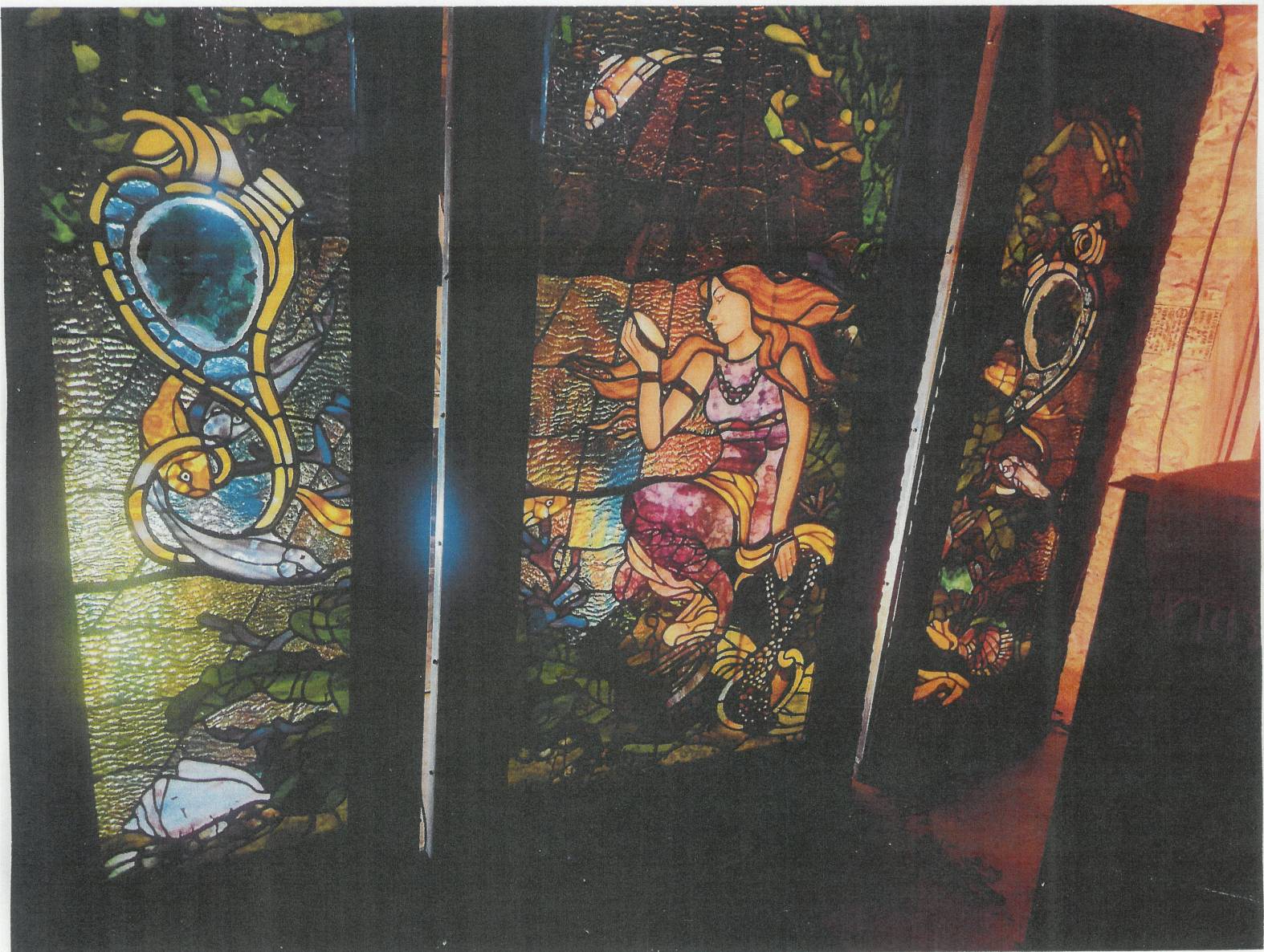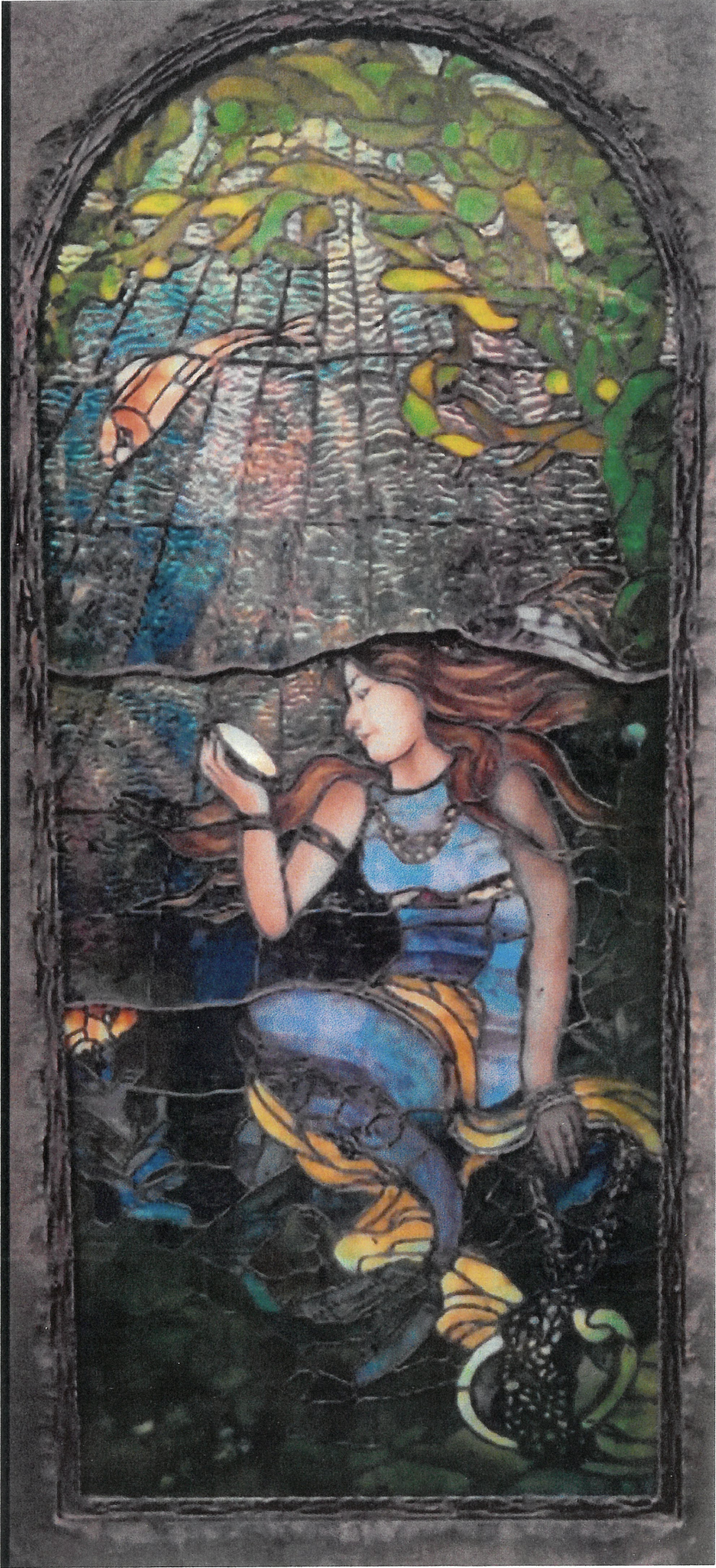
The Mermaid Triptych
The Drawing:
“I began the Mermaid Triptych in the mid double oughts, only to complete it over a decade later. During the double oughts I made sconces and other pieces with nautical themes in collaboration with my friend Dave Foley. The pieces Dave and I made included various seashells, some translucent, some not, typically iridescent, and always complementary to glass. One dome comprised an inverted “fishnet” styled motif composed of a copper wired/rope-like came, with the same background glass as that in our mermaid composed within a perimeter of Haliotis fulgrens (green abalone) shells, all individually beautiful. That dome hung over Dave’s bar in his Vernon workspace. That piece served as inspiration for the glass and came selected for and executed in the Mermaid Triptych.
Around that time, Dave showed me the 1882 chalk drawing of the mermaid stained glass tryptich by Elihu Vedder, a well-known late 19th century artist. The chalk drawing he showed me is on display at the Cooper Hewitt Museum in New York City. It was, I believe, preliminary for the stained glass project, a project which had been commissioned through Associated Artists, of which Louis Comfort Tiffany was a partner. The stained glass window itself, was to be executed by Tiffany Stained Glass Studio for the home of Wells Fargo President Ashbel H. Barney at 101- 103 East Thirty-Eighth Street (67 Park Ave) in Manhattan. There is no trace of the actual window set, but it was presumably made. Unfortunately, whether made or not, it is unlikely to have survived a severe fire which gutted and leveled that East Thirty-Eighth Street home on November 16, 1901.
The Kelp Forest:
Following the closure of my last glass studio in 2002, I enrolled in Marine Biology courses, first, at Santa Monica College. I continued with Marine Biology studies, and over time I acquired a Bachelor's Degree in Marine Biology from UC Santa Cruze, and then a Master's of Applied Science in Aquaculture from James Cook University in Townsville QLD. One major segment of my several years of Marine Biology study at UC Santa Cruz involved ninety-seven dives in Monterey Bay kelp forests, experiencing the kelp forest environment firsthand. I saw that light varied greatly at seafloor depth, and that the colors in the kelp forest environment were beautiful, predominantly greens and blues, with some purple hues. Prevailing light depended on factors such as overcast vs sunlit skies, time of day, or the thickness of the kelp canopy. There was pretty much always floating debris in the water. Occasional turbulence stirred that debris as random sea life acted out daily routines, lingering, curious, moving with the currents, and typically, likely, just looking for food despite distraction, of which I was one… not unlike our mermaid. I was looking for tiny reef fish. She was contemplating her reflection in a seashell.
Verisimilitude:
Vedder’s chalk drawing is simple and idealized. It depicts a clear single tone light blue sea environment. I suspect there was no real effort at verisimilitude. After all, it was a mermaid. I know such coloring and uniformity was not to be found in the kelp forests at the seafloor in Monterey, where I dove, and our mermaid is clearly in a kelp forest. I suspect Vedder’s drawing was conceptual, initial, preliminary, reflecting perhaps little more than the color chalk he had on hand. Ultimately, Tiffany would have selected the glass… and I wish I could know what Tiffany actually did in his execution of the window, but unfortunately the window no longer exists. Tiffany was a painter who heavily emphasized the use of glass for lifelike color rendering in his windows. He championed the minimization of paint in favor of glass to depict lifelike color in his landscape and floral theme windows, and it is those for which he was most famous.
The Mermaid With Fish:
“The Mermaid With Fish” was one of Louis Comfort Tiffany’s favorites, kept in his personal collection. It is now viewable in the Field Museum. That mermaid is composed against, almost within, a floating, surreal, flowing, watery background, of blues and greens. “The Mermaid With Fish” consciously depicts a ghostlike apparition. She blends into that watery background, hidden almost, as if camouflaged.
The Vedder drawing, as this window, is thematically different. It aspires, and I aspired, to simulate the colors and feel of a kelp forest environment, with a solid sea floor on which our young mermaid can carry on with her day, settled on her boulder, contemplating her image, as a young mermaid, or any young girl might, after or while discovering her reflection in a seashell. Vedder’s mermaid is temperamentally as well as thematically different than the “Mermaid With Fish”.
Materials:
There are up to four layers of glass where there is painting, on the hands, arms, and face. One layer there is painted, one provides opacity, and the other imparts a skin-like texture, with the watery layer atop. One layer of glass covers pretty much all else, for a total of two. The top watery layer was fired with frits on a dimpled mold to produce a watery look with some occasional floating debris and shading.
I used seashells for her necklaces, including the one she wears, and I incorporated well over a hundred sea shells in the windows. At least 120 are wrapped in braided copper in the necklace in her hand, alone.
Much of the structural channel is layered with heavy braided copper. That was done partially to provide added strength but aesthetically as well to suggest a sea net in the grid, akin to what I’d done earlier in Dave’s fishnet dome. The rest of the came is reinforced with a copper wire colonial profile on the face of a lead channel.
I framed the glass in Pennsylvania Bluestone. The frames are absurdly heavy, but they are for looking at. Not moving. The color and texture is intended to finish and complement the colors and materials in the glass and metal work, such that the materials comprise the art, and complement and correspond to the colors and materials used, glass metal, and stone alike. The idea was certainly not mobility.
The girl:
Elihu Vedder used his daughter, Anita Herriman Vedder, for a model, not just for his mermaid but for other works, such as the Cumean Sibyl, of which I have, quite coincidentally, possessed a print for forty years. I took liberty to alter his mermaid, and the image in mine is a composite of my twin daughters, face and shape. Anita was a larger girl with a strong jutting jaw.”- Martin Duffy
Dimensions:
The center window stone (OD) is 66 ¼” high by 31 ¼” wide.
The sidelight stone (OD) is 58 ¼” high and 19 ¾” wide,
Side by side there is a total of 70.75 inches with no space between.
I recommend the set be framed allowing a six inch space between, so the set would occupy an 82. 75” wide space.

